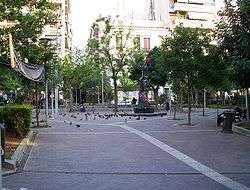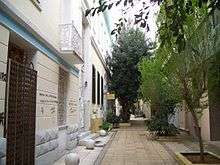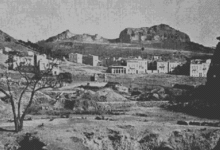Exarcheia
| Exarcheia Εξάρχεια | |
|---|---|
| Neighborhood | |
 The central square in 2007 | |
| Coordinates: 37°59′10″N 23°44′5″E / 37.98611°N 23.73472°ECoordinates: 37°59′10″N 23°44′5″E / 37.98611°N 23.73472°E | |
| Country | Greece |
| Region | Attica |
| City | Athens |
| Postal code | 106 80, 106 81, 106 82, 106 83 |
| Area code(s) | 210 |
| Website | www.cityofathens.gr |
Exarcheia (Greek: Εξάρχεια pronounced [eˈksaɾ.çi.a]) is a neighborhood in downtown Athens, Greece close to the historical building of the National Technical University of Athens. The Exarcheia region is famous as a home for Greek anarchists. It took the name from a merchant named Exarchos (Greek: Έξαρχος) who opened a large general store there. Exarcheia is bordered on the east by Kolonaki and is framed by Patission Street, Panepistimiou Street and Alexandras Avenue. Exarcheia is renowned for being Athen's historical core of radical political and intellectual activism.[1]
Features
The National Archaeological Museum of Athens, the National Technical University of Athens and Strefi Hill are all located in Exarcheia. The central square features many cafes and bars with numerous retail computer shops located mainly on Stournari street, also called the Greek Silicon Valley. Located on Exarcheia square is one of the oldest summer cinemas of Athens, called "Vox", as well as the Antonopoulos apartment building, known as the "Blue Building", because of its initial color, which is a typical example of modern architecture in Athens during the inter-war period. Due to the political and intellectual character of the neighborhood, many bookstores, fair trade shops and organic food stores are also located in Exarcheia.[2] Exarcheia is also known for having comic book shops.
History and political significance

The district of Exarcheia was created between 1870 and 1880 at the confines of the city and has played a significant role in the social and political life of Greece. It is there the Athens Polytechnic uprising of November 1973 took place. In December 2008, the murder of 15-year-old Alexandros Grigoropoulos by a policeman in Exarcheia caused rioting throughout Greece.
Exarcheia is a place where many intellectuals and artists live and an area where many socialist, anarchist, and anti-fascist groups are accommodated. Exarcheia is also an art hub where theatrical shows and concerts take place around the central square. The headquarters of PASOK, a Greek political party that supported austerity measures dictated by the European Union in 2009, are also located in the neighborhood and has been a target of attacks by anarchists.[3] Police stations and other symbols of authority (and capitalism) such as banks are often targets of far-leftist groups.[4][5] One can find numerous anti-capitalist graffiti in the district.[6]
Protests that begin in Exarcheia evidence diverse political formations and coalitions, including dispossessed young people, migrants, anti-authoritarians, anarchists, and Greek citizens from the moderate to extreme on both ends of the political spectrum.[7][8]
The European refugee crisis resulted in an enormous migration to Greece - in 2017, 55,000 people throughout Greece were registered as permanent residents. When borders between Greece and the European Union were closed, many migrants were forced to stay in camps that lacked housing or hygiene infrastructure. As a result, refugees and migrants sought alternative options within Athens, including squats in the Exarcheia neighborhood.[9]
Athens Polytechnic uprising
On December 17, 1973, the Greek military raided the student occupation of the Athens Polytechnic University, killing 40 civilians. The events resulted in public outrage and the passing of the Academic Asylum Law, which designates university campuses as off-limits to police and military personnel.[10] This law has contributed to the prevalence of protests within Exarcheia, as the Polytechnic functions as a site of insurgent coordination as well as a safe haven from police violence.[11]
2008 Greek riots
On December 6, 2008, a Greek police special guard shot and killed 15-year-old Alexis Grigoropoulos within blocks of the Athens Polytechnic University, leading to the largest protests in Greece since the end of the dictatorship in 1974. Protests originated in Exarcheia and the neighborhood continued to be the epicenter of demonstrations as they spread across Athens.[12]
In the aftermath of the riots, collectives and movements in Exarcheia expanded initiatives experimenting with new political formations, especially to provide public spaces organized around an anti-hierarchical and anti-commercial ethos. For example, activists turned a parking lot into the guerrilla Park Navarinou, which hosted events such as ticket-free movie screenings and anti-consumerist fairs. The Sporos collective developed solidarity economies through trade and sale of Zapatista-produced goods, and the Skoros collective promoted re-use, recycling, and sharing practices. Other new and renewed political formations in the neighborhood included producer or consumer cooperatives and collective kitchens.[13]
Migrant communities
Exarcheia is the site of a large migrant and refugee community. The overcrowding and abuse within Greek refugee camps has propelled a movement of squatting within Athens and across Greece. There are more than a dozen squats in Athens, primarily centered in Exarcheia, serving as housing, healthcare, and social centers for refugees, migrants, or anarchists. These squats provide space for highly diverse communities and coalitions. For example, the City Plaza squat houses Afghanis, Iraqis, Iranians, Syrians, Kurds, Palestinians, and Pakistanis within a single occupied hotel. Many of these spaces aim to recreate the feeling of home for displaced migrants and refugees.[14]
However, far-right, neo-fascist, and nationalistic organizations have been connected to multiple attacks and burnings of refugee squats. In addition, the Syriza government has recently evicted multiple squats in Athens.[15][16]
In addition, Exarcheia and bordering Omonoia have been the focus specialized policing tactics in Greece. These include MAT, (Public Order Restoration Units) an anti-protest police unit implemented after the dictatorship; Operation Virtue, which used blockaded areas and rapid raids of public spaces to capture undocumented migrants in the 1970s and 1980s; and Operation Xenios Zeus, which implemented stop-and-search and document checks for foreigners in 2012.[17]
Notable people

- Betty Arvaniti, actress
- Nikolas Asimos, songwriter, singer
- Eleni Kastani, actress
- Sophia Philippidou, actress
- Shant Rising. Communist activist
- Mary Tsoni, singer and actress
See also
References
- ↑ Chatzidakis, Andreas (May 2013). "Commodity Fights in Post-2008 Athens: Zapatistas Coffee, Kropotkinian Drinks and Fascist Rice" (PDF). Ephemera. 13: 459–468.
- ↑ City of Athens Portal, Retrieved August 23, 2007 Archived September 30, 2007, at the Wayback Machine.
- ↑ "Gun from Greek PASOK shooting used in past guerrilla attacks -police". Reuters. November 7, 2017. Retrieved 2018-02-05.
- ↑ "Greek anarchist youths throw petrol bombs at cars outside central Athens police station", Pravda, April 26, 2007. Accessed August 23, 2007.
- ↑ "Greek police shooting sparks riot", BBC, December 7, 2008, Retrieved December 7, 2008.
- ↑ Pilic, Damir (23 November 2015). "Red Revival: The Fall and Rise of Karl Marx". Balkan Insight.
- ↑ Astrinaki, R. ""(Un)hooding" a Rebellion: The December 2008 Events in Athens". Social Text. 27 (4 101): 97–107. doi:10.1215/01642472-2009-056.
- ↑ Apoifis, Nicholas. "Fieldwork in a furnace: anarchists, anti-authoritarians and militant ethnography". Qualitative Research. 17 (1): 3–19. doi:10.1177/1468794116652450.
- ↑ Chtouris, Sotiris (January 2017). "Refugee Flows and Volunteers in the Current Humanitarian Crisis in Greece". Journal of Applied Security Research. 12: 61–77 – via Taylor and Francis+NEJM.
- ↑ Vradis, Antonis (March 2009). "Greece's winter of discontent". City. 13: 146–149 – via Taylor & Francis Online.
- ↑ Vasilaki, Rosa (2017-04-17). "We are an image from the future': Reading back the Athens 2008 riots". Acta Scientiarum. Education. 39 (2): 153–161. doi:10.4025/actascieduc.v39i2.34851. ISSN 2178-5201.
- ↑ Vradis, Antonis (2009). "Greece's winter of discontent". City. 13 (1): 146–149. doi:10.1080/13604810902770754.
- ↑ Chatzidakis, Andreas (May 2013). "Commodity Fights in Post-2008 Athens: Zapatistas Coffee, Kropotkinian Drinks and Fascist Rice" (PDF). Ephemera. 13: 459–468.
- ↑ Koptyaeva, Alexandra (June 2017). "Collective homemaking in transit". Forced Migration Review. 55: 37–38 – via EBSCOhost.
- ↑ "Greek police arrest 12 amid raids on anarchist squats". www.aljazeera.com. Retrieved 2018-04-04.
- ↑ Strickland, Patrick. "Greek anarchists organise for refugees as 'state fails'". www.aljazeera.com. Retrieved 2018-04-04.
- ↑ Dalakoglou, Dimitris (2013). "The Crisis before "The Crisis": Violence and Urban Neoliberalization in Athens". Social Justice. 39: 24–42 – via ResearchGate.